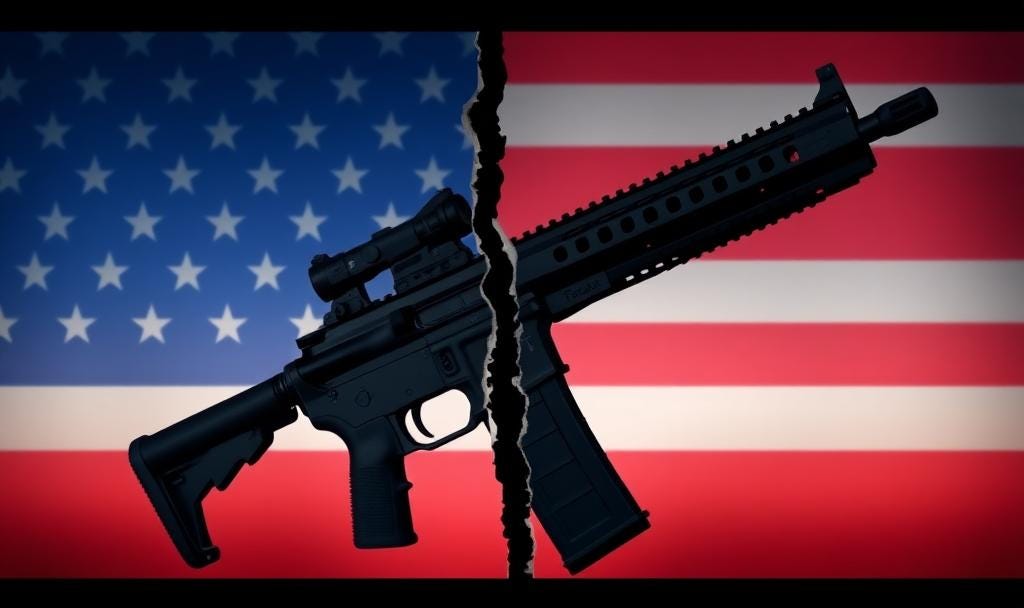In the United States, few debates burn hotter, or cut deeper, than the one over gun rights. It is a clash of constitutional principle versus public safety, a conversation that has shaped American society for generations and, in recent years, found itself dramatically re-litched by the nation's highest court. The result is a landscape of profound legal uncertainty and a daily reality shifting beneath the feet of millions.
At the heart of this enduring conflict lies the Second Amendment to the U.S. Constitution: "A well regulated Militia, being necessary to the security of a free State, the right of the people to keep and bear Arms, shall not be infringed." For nearly 150 years, this declaration remained largely "legally inert"¹. Early Supreme Court rulings like United States v. Cruikshank (1876) and Presser v. Illinois (1886) limited the Amendment's reach, applying it only to federal action and upholding states' rights to regulate militias. U.S. v. Miller (1939) further cemented this view, finding no right to possess a short-barreled shotgun when no militia use was shown.
The Seismic Shift of Heller and McDonald
The 21st century witnessed a dramatic awakening of the Second Amendment. In District of Columbia v. Heller (2008), the Supreme Court delivered a landmark ruling. For the first time, it held that the Second Amendment protects an individual right to possess a firearm unconnected with militia service, particularly for self-defense within the home. This decision struck down Washington D.C.'s handgun ban, declaring it prohibited an entire class of arms "overwhelmingly chosen for lawful purposes." Two years later, McDonald v. City of Chicago (2010) extended Heller's reach, incorporating this individual right against state and local governments through the Fourteenth Amendment's Due Process Clause. Suddenly, the core right of self-defense in the home became a nationwide mandate.
The Court also expanded the definition of "bearable arms." In Caetano v. Massachusetts (2016), it clarified that the Amendment covers modern self-defense tools not in existence at the founding, such as stun guns. This underscored the evolving nature of the protected right.
Bruen: A New Era of Constitutional Scrutiny
The most recent and profoundly impactful decision came with New York State Rifle & Pistol Association v. Bruen (2022). This ruling struck down New York's "proper-cause" requirement for concealed-carry permits, asserting that the individual right extends beyond the home to carrying arms in public for self-defense.
Bruen did more than expand the right to carry. It jettisoned the familiar two-step "interest-balancing" framework that many lower courts had used to evaluate gun laws. No longer would courts weigh public safety concerns against the right to bear arms. Instead, Justice Thomas's majority opinion established a stringent "plain-text plus history-and-tradition" test:
If the conduct falls within the Amendment's text, it is presumptively protected.
The government must then show the regulation is consistent with historical analogues from the founding era or the 19th century.
This means modern public safety justifications, like crime-reduction statistics or technological advances, no longer suffice on their own. Courts are now tasked with acting as historians, scouring antebellum statutes and colonial ordinances to determine if a modern restriction has a "well-established and representative" historical twin. This dramatically elevates the burden on regulators and has reshaped federal and state firearms policy.
Living with Bruen: Immediate and Future Shockwaves
The impact of Bruen was immediate and far-reaching:
From May-Issue to Shall-Issue: States like New York, California, New Jersey, and Massachusetts, which previously had discretionary "may-issue"² concealed-carry regimes, were forced to rewrite their laws to become "shall-issue." This means permits must be granted if an applicant meets objective criteria, leading to skyrocketing permit applications in these areas. New York City, for instance, saw nearly 50% of its 2022 firearm permit applications filed in just the two months after Bruen.
A Flood of Litigation: Almost every significant gun regulation in the U.S., from assault weapon bans to magazine-capacity limits to "sensitive places" designations, is now being challenged under Bruen's history-and-tradition test. Lower courts are grappling with what constitutes a valid historical analogue, creating deep legal uncertainty and fueling a steady stream of appeals and Supreme Court petitions.
Policy Redesign: Legislators are scrambling to tailor new regulations that can withstand Bruen's scrutiny. This involves expanding training requirements, fortifying background check mandates, and carefully delineating "sensitive places" with historical grounding. Even the federal Bipartisan Safer Communities Act, passed days after Bruen, explicitly cited the decision's demand for constitutionally grounded justifications.
Judicial Partisanship: Early empirical evidence reveals a stark partisan divide in post-Bruen rulings, with Republican-appointed judges far more likely to grant relief in Second Amendment claims than their Democratic-appointed counterparts. This disparity underscores the influence of judicial background and signals continued unpredictability in lower-court outcomes.
Clarifications and Emerging Challenges: While Bruen created new hurdles, the Supreme Court has also offered some clarifications. In U.S. v. Rahimi (2024), the Court upheld a federal ban on gun possession for individuals under domestic violence restraining orders, recognizing a historical tradition of disarming dangerous individuals. However, the same year, Garland v. Cargill (2024) invalidated the ATF's bump stock ban, finding no statutory basis to classify them as machine guns. These rulings hint at the intricate legal dance now underway.
Beyond these immediate shifts, Bruen's future implications include sustained litigation, further erosion of certain gun control measures lacking historical analogues (like broad bans on modern firearms or age restrictions for young adults), and constant re-evaluation of "sensitive places."
Echoes of History in Today's Laws
Today's gun laws are not just products of modern debates; they bear the indelible marks of history:
Militia Mandates: Founding-era laws like the 1792 Militia Act compelled every able-bodied male to own and register service-grade arms, reflecting the Founders' view of firearms as integral to collective defense. This historical emphasis continues to influence debates on defining "bearable arms."
Racially Targeted "Black Codes": The discriminatory "Black Codes" enacted in the Reconstruction South explicitly barred formerly enslaved Black people from gun ownership to maintain white supremacy. These dark precedents, while abhorrent, regrettably persist in legal memory, informing arguments over whether historical regulations disarming inherently "dangerous" classes can guide today's disarming of high-risk individuals.
Twentieth-Century Milestones: Major federal acts like the National Firearms Act of 1934 (targeting gangland weapons), the Gun Control Act of 1968 (expanding licensing and banning sales to felons), and the Brady Handgun Violence Prevention Act of 1993 (establishing federal background checks) layered procedural safeguards that contemporary courts now weigh against Bruen's historical test.
The Unending Debate: Rights Versus Safety
The arguments for and against stricter gun regulations remain sharply divided:
For Stricter Regulations: Proponents point to the staggering toll of gun violence in the U.S., with approximately 40,000 firearm deaths per year (roughly 60% suicides). They highlight nations with tight controls that report dramatically fewer firearm fatalities, arguing that measures like universal background checks (supported by ~90% of Americans), waiting periods, safe storage laws, and "red flag"³ protocols could curb mass shootings, accidental discharges, and suicides, thereby enhancing overall community safety.
Against Stricter Regulations: Critics argue that mental health issues, socioeconomic disparities, and criminal intent drive violence more than gun availability, contending that tighter laws miss the true targets. They view the Second Amendment as an individual right fundamental to self-defense and protection against tyranny, fearing that stricter statutes erode civil liberties without clear public safety gains. The concern is often raised that "criminals do not obey laws," making new regulations ineffective against those who pose a threat.
Global Lessons and U.S. Exceptionalism
The U.S. gun control debate stands in stark contrast to that of many other developed nations, largely due to its unique constitutional framework.
Australia (1996): Following the Port Arthur massacre, federal and state governments swiftly banned semi-automatic rifles and shotguns, imposed a 28-day waiting period, and conducted a A$500 million buyback that destroyed one-third of civilian firearms. Since then, there have been zero mass shootings.
United Kingdom (1996): Post-Dunblane, the UK outlawed all civilian handguns and imposed rigorous licensing and storage rules. Today, it boasts one of the world's lowest firearm homicide rates (0.04 per 100,000).
Japan: With civilian ownership limited to shotguns and air rifles, requiring exhaustive background checks, mental health evaluations, and annual renewals, Japan records fewer than five gun deaths per year (0.02 per 100,000).
Canada: Ottawa has expanded background checks, banned certain military-style firearms and handguns, and proposed buyback programs. Despite these efforts, Canadian police data indicate that over 90 percent of crime guns trace to U.S. trafficking, highlighting the challenge of cross-border illicit flows.
Brazil: Easing restrictions in 2019 led to a temporary spike in firearm homicides, which reversed in 2023 when stricter licensing and registration were reimposed, illustrating how loosening rules can drive violence upward, and how re-regulation can reduce it.
These international examples reveal that rapid, unified action to reduce gun violence is possible when not constrained by a constitutional barrier like the U.S. Second Amendment. They underscore the effectiveness of comprehensive bans, mandatory buybacks, and strict licensing regimes in dramatically reducing gun-related deaths.
"The right to bear arms does not begin where public safety ends; it begins where responsible freedom finds its balanced place."
— Angana Sarmah
The Road Ahead
Bruen's legacy is an ongoing legal revolution. Courts nationwide are parsing what qualifies as a "historical analogue," and the Supreme Court's docket is likely to see multiple petitions on assault weapon bans and magazine limits. States will continue to innovate, tailoring "sensitive-place" zones and building stronger procedural safeguards into red-flag laws to navigate judicial scrutiny.
The complex interplay between individual rights and communal well-being ensures that the gun debate in America will remain at the forefront of legal and legislative battles for the foreseeable future. Every new measure, from concealed carry permits to ammunition background checks, will invite a fresh litigation front, testing the boundaries of a right now deeply rooted in a selective reading of America's past.
Legal Disclaimer:
This article provides general information for educational purposes only and does not constitute legal advice. Gun laws are complex and constantly evolving; readers should consult with a qualified legal professional for advice pertaining to their specific circumstances.
References:
United States v. Cruikshank, 92 U.S. 542 (1876).
Presser v. Illinois, 116 U.S. 252 (1886).
U.S. v. Miller, 307 U.S. 174 (1939).
District of Columbia v. Heller, 554 U.S. 570 (2008).
McDonald v. City of Chicago, 561 U.S. 742 (2010).
Caetano v. Massachusetts, 577 U.S. 799 (2016).
New York State Rifle & Pistol Association, Inc. v. Bruen, 597 U.S. 1 (2022).
United States v. Rahimi, 601 U.S. ___ (2024).
Garland v. Cargill, 602 U.S. ___ (2024).
Council on Foreign Relations - U.S. Gun Policy: Global Comparisons
Duke Firearms Law Center - Repository of Historical Gun Laws





